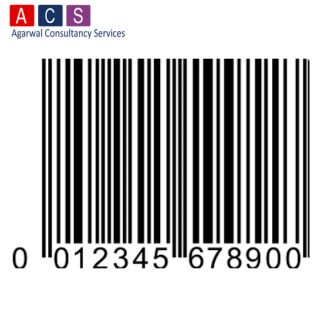BARCODE REGISTRATION
A Barcode Registration (often seen as a single word, barcode) is the small image of lines (bars) and spaces that is affixed to retail store items, identification cards, and postal mail to identify a particular product number, person, or location. A barcode reader is used to read the code.
Get Started
Among India's Top 100 IP/Legal Consulting Firm
Easy Payment
3,000 + Clients
Communication
14 Years of Expertise
4.3 Google Rating
What People Say About Us
EXCELLENTTrustindex verifies that the original source of the review is Google. Good service.Trustindex verifies that the original source of the review is Google. Good Service for trademark serviceTrustindex verifies that the original source of the review is Google. Good consultancyTrustindex verifies that the original source of the review is Google. If you're looking to register a trademark, I highly recommend using ACS. They offer excellent service, their team is very courteous, and they respond promptly.Trustindex verifies that the original source of the review is Google. V nice behaviour v good workTrustindex verifies that the original source of the review is Google. Excellent service for trade mark serviceTrustindex verifies that the original source of the review is Google. V nice behaviour v good workTrustindex verifies that the original source of the review is Google. Excellent service for trade mark serviceTrustindex verifies that the original source of the review is Google. Quick & accurate with excellent services, happy to work with you.Trustindex verifies that the original source of the review is Google. Quick & accurate with excellent services, happy to work with you.Trustindex verifies that the original source of the review is Google. If you're looking to register a trademark, I highly recommend using ACS. They offer excellent service, their team is very courteous, and they respond promptly.Trustindex verifies that the original source of the review is Google. mannerism poor, dont know how to speak, very bad person, very bad behaviour for unknown persons.Trustindex verifies that the original source of the review is Google. Nice experience. They really helped me getting a trademark for an apparel brand 'SYBARITE'.Trustindex verifies that the original source of the review is Google. Very professional Service.Trustindex verifies that the original source of the review is Google. "Highly impressed with the expertise and professionalism of [ ACS] They guided me through the entire trademark registration process . Excellent communication and prompt responses to all my queries. I highly recommend their services to anyone seeking trademark registration assistance."Trustindex verifies that the original source of the review is Google. Good service.
WHAT IS BARCODE?
A barcode (often seen as a single word, barcode) is the small image of lines (bars) and spaces that is affixed to retail store items,identification cards, and postal mail to identify a particular product number, person, or location .A barcode reader is used to read the code.

REASONS TO USE BARCODE
- Barcodes eliminates the possibility of human error. The data entered manually is subject to error. A barcode scan is fast and reliable and takes less time than the data entered by hand.
- Cost effectiveness. Over any period of time barcode saves money.
- Barcode provide security against theft, reduction in loss and peace of mind.
- Barcode offers automatic product identification, extremely fast recognition and implementation of data.
- Barcode error free, for every 10,000 scans made by an optical scanner, there are an average of one error.
- Barcode can be affixed to any surface.
- Modern business technology to be adopted to stay competitive in the market.
- Barcode will stay in the market and it is getting better all the time.
- The data encoded is scalable as per the requirement of the user and for more data more barcodes to be added.
- No specialist required for operating a barcode.
TYPES OF BARCODE
There are about 30 major barcode formats that are commonly used today based on linear numeric, linear alpha-numeric and 2 dimensional designs. Each of these major formats has seen adoption in particular applications that can take advantage of their unique quantities.
Some of the common types are:
- Code 39- is a common barcode type used for various labels such as name, badges, inventory and industrial applications.
- Code 128- is a high density linear barcode symbolically defined in ISO/IEC 15417:2017. It is used for numeric and alpha numeric barcodes only.
- Interleaved 2 of 5- is a continuous 2 width barcode semiology encoding digits. It is used commercially on 135 film for ITF-14 barcodes and on cartoons of some products.
- Universal Product Code (UPC) – is a type of code printed on the retail product packaging to aid in identifying a particular item. It consists of two parts- the machine readable barcode, which is a series of unique black bars and the unique 12 digit number beneath it.
- International Article Number (EAN) – is a standard describing a barcode semiology and a numbering system used in global trade to identify a specific retail product type in a specific packaging configuration from a specific manufacturer.
- PDF417- is a stacked linear barcode format used in a variety of applications such as transport, identification cards and inventory management.
- Data Matrix- is a two dimensional code consisting of black and white cells or dots arranged either in a square or rectangular pattern. The information to be stored is text or numeric data. Data size is from few bytes to 1556 bytes.
Quick Response (QR) codes- is a type of barcode that can be read easily by a digital device and which stores information as series of pixels in a square shaped grid. QR codes are frequently used to track information about products in a supply chain and often used in marketing and advertising campaigns.
FEES FOR BARCODE REGISTRATION
The fees for barcode registration is dependent on the following:
- Turnover of the company
- Number of barcodes required
- Subscription period.
Depending on all these factors, the fees vary from around Rs 44,000 to Rs 2, 20,000/-
PROCESS TO OBTAIN BARCODE REGISTRATION
The process of barcode registration is purely online. In India the authority for registering barcodes is GS1 India. The steps involved are:
- Filing of the application
- Uploading all the relevant documents
- Type and number of barcodes to be selected
- Confirm all the details
- Paying applicable fees
- Tracking the status
DOCUMENTS REQUIRED FOR BARCODE REGISTRATION
- Letter requesting allotment of barcode
- Pan card of the entity
- Copy of audited balance sheet
- GST Registration Certificate
- Certificate of Incorporation/Partnership deed
- MOA/AOA
- Copy of cancelled cheque
FAQs
A: Barcodes are simply information that has been put into a visual form that machines can read. This allows for automatic identification and data capture (AIDC) which means collecting information from a person, thing, image or sound without having to enter the data by hand.
A: Eliminates the possibility of human error, efficient and accurate data capture and facilitates tracking and tracing of products.
A: GS1 India Barcode
A: By applying GS1 Barcode one get global exposure and freedom to sell products across the world seamlessly.
A: GS1 Barcodes.
A: Individual barcodes required for each product, otherwise there will be confusion when it comes to product distribution, inventory management and sales tracking.
A: No, unless one is doing second run or batch of a previously barcoded product. In every other scenario a new barcode is required.

